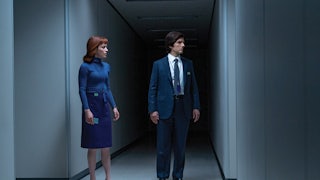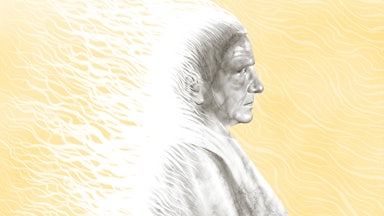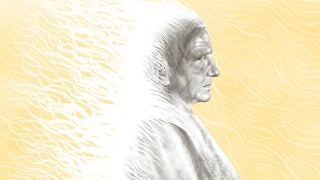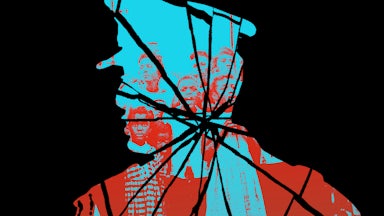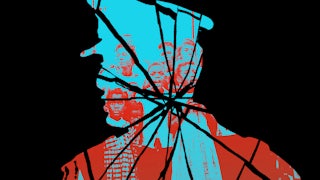A woman is walking along a cold seaside plain lined with thousands of black tree trunks. Together, the trunks create “the impression of a thousand men, women, and haggard children huddling in the snow.” Surely, she tells herself, this is a graveyard. If it is, though, what will happen to the bones buried under the trees when the tide comes in?
When she wakes up, we learn that this dream is not new to her. In fact, it’s among the nightmares that have haunted her for years. Kyungha, the protagonist of Han Kang’s novel We Do Not Part, is a writer; in 2012, six years before the book starts, she began a novel that she describes only as “my book about the massacre in G—.” Her research gave her violent dreams that led her to rush through the project, hoping the nightmares would end on publication. This did not happen, and she also began to suffer from debilitating migraines and suicidal ideation. Nearly everyone in her life, including her family, left her, telling her “they couldn’t bear to witness” her state. Kyungha takes her suffering as punishment for the hubris of telling herself she could move on from her novel. “Having decided to write about mass killings and torture,” she reflects, “how could I have so naively—brazenly—hoped to soon shirk off the agony of it, to so easily be bereft of its traces?”
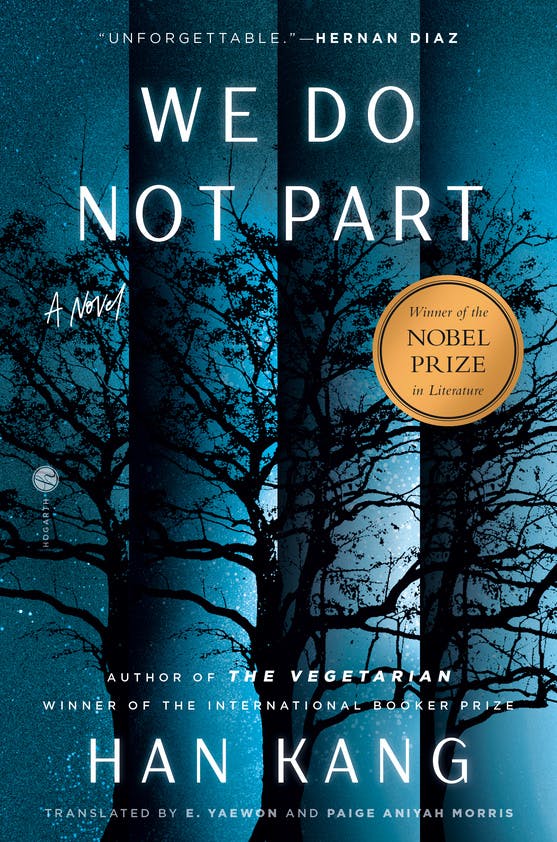
Any reader familiar with Han’s work would be tempted, at this early point in the novel, to conclude, wrongly, that Kyungha is a stand-in for her creator. Han is divorced and Kyungha appears to be, too; both have one child; both suffer from migraines; and Kyungha, like Han, wrote a book about a “massacre in G—” that came out in Korean in 2014. In real life, this novel is Human Acts, an astonishing polyvocal narrative about the Gwangju Uprising, a 1980 student protest against the dictator Chun Doo-hwan, whose military reacted by slaughtering students and other demonstrators. (As I drafted this piece, in early December, South Korea’s President Yoon Suk Yeol declared martial law for the first time since the Chun regime ended, reminding many Gwangju survivors of that period.)
Han won the Nobel Prize in literature in 2024, and We Do Not Part is her fifth novel to appear in English, rendered with somber yet startling beauty by co-translators e. yaewon and Paige Aniyah Morris. Within Han’s translated body of work, We Do Not Part reads as a companion to Human Acts. While the other three novels are narrower and more domestic in focus, We Do Not Part also takes on a tremendous historical trauma. Its central subject is the suppressed memory of another mass killing, the Jeju Massacre, a yearslong extermination of suspected leftists on the island of Jeju after the Korean Peninsula was partitioned. Around 30,000 people, roughly a tenth of Jeju’s population, were murdered. Although the Korean army carried out the executions, South Korea was under U.S. military rule at the time; the United States has never admitted responsibility.
We Do Not Part bears witness—or, rather, demands that Kyungha bear witness—to these deaths. In that sense, it is a straightforwardly political novel, but that by no means requires it to be a straightforward one. It certainly isn’t a direct investigation of either Han’s life or the effect that writing Human Acts had on her. Kyungha may share some biographical details with her creator, but what matters more is her commonality with countless readers: Burdened by what she’s learned about her country’s historical atrocities, she badly—“resolutely,” as she repeatedly puts it—wants to avoid learning more. She can’t. Fate won’t let her. We Do Not Part is as supernatural as it is historical. It’s a tale of ghosts and omens, of dreams bearing messages, of many linked kinds of haunting. The novel takes Kyungha on a terrifying journey toward knowledge, one that manages to thin the line between life and death while leaving the one between past and present impassably thick. It has as much in common with the Mexican modernist Juan Rulfo’s pitch-black masterpiece, Pedro Páramo, an eerie critique of caciquismo set in a town where everyone is dead, as it does with Human Acts. Both books ask the same question of their protagonists and their audience alike: After an atrocity, what does it mean to bear witness—and when do witnesses get to close their eyes?
Han Kang was born in Gwangju in 1970. Her family moved to Seoul when she was nine, mere months before the uprising; she didn’t learn what had happened in her hometown until she was 12. Her discovery affected her profoundly. Deborah Smith, who translated or co-translated all of Han’s novels to appear in English before We Do Not Part, describes Han in the foreword to Human Acts as “a writer who takes things deeply to heart.” What this means, on the page, is an unremitting emotional intensity and moral rigor. Han does not write with levity. If she allows her reader a rest of any sort, it’s through lyricism, description, and dreams such as the black-tree one that appears, like the chorus of a song, throughout We Do Not Part.
Still, Han isn’t given to writing heroes or paragons. With the exception of some figures in Human Acts, her characters aren’t unusually brave. Kyungha certainly isn’t. Despite the political conviction that led her to research and write about the massacre in G—, she shied away, throughout the process, from studying any other moments of violence in South Korea, including the Jeju Massacre—though her best friend, a photographer, documentarian, and woodworker named Inseon, is from Jeju and has made a triptych of films about war and memory that includes one in which she describes her own family’s trauma during and after the killings (she denies, however, that it’s about the massacre more broadly). Kyungha admires the triptych, if somewhat dispassionately. She doesn’t quite seem to recognize that it investigates the same question of her novel, one that is central to Han’s body of work: As Han wrote in a 2017 New York Times opinion piece, “I wanted to ask what it is that makes human beings harm others so brutally, and how we ought to understand those who never lose hold of their humanity in the face of violence.”
At the beginning of We Do Not Part, Kyungha may be close to losing her humanity, though the only person she wishes to harm is herself. Although she has decided to reenter the “lived-in world” rather than killing or permanently isolating herself, she has no job, family, or friends to attend to except Inseon, who has moved to rural Jeju and from whom she has drifted significantly. Formerly, their relationship was a mix of sisterhood and creative collaboration: For years, they’ve discussed making a piece of video art that replicates Kyungha’s tree-trunk dream, but Kyungha backs out. Inseon proceeds regardless, and Kyungha refuses to engage, even with the knowledge that she’s further harming her friendship with Inseon. Her creativity, it seems, has vanished; she can feel that “the wiring inside me that would sense beauty was dead or failing.” She’s utterly disconnected from her life and surroundings.
An awakening of sorts arrives when Inseon texts her from a Seoul hospital where she’s recovering from emergency hand surgery. Kyungha sprints to her bedside, and, before the day is out, she’s en route to Jeju to feed and care for Inseon’s pet bird. She understands that this request will tax her immensely. Just getting to Inseon’s house is a colossal challenge. She has a migraine; it’s snowing in Jeju; she’s not sure how to get to the house; and she’s going to stand out immediately as an outsider on the island, which is culturally distinct from the mainland in many ways. Jeju has its own language, Jeju-mal, which is related to but not mutually intelligible with Korean, and which Morris and yaewon occasionally include in their text. Inseon sometimes refers to her parents as umung and abang, not mother and father, a translation decision that lets Anglophone readers feel the distance between Jeju and the mainland that Kyungha feels.
Still, she’s drawn to Jeju. Despite her supposed inability to register beauty, she narrates her trip through the snow, which involves a plane, a bus, and a walk through the woods, gorgeously. Kyungha’s hike to Inseon’s house transforms the novel, and Han gives the scene a patient, poetic loveliness that is common in her work, but rare in contemporary literature; it’s among the reasons she won the Nobel, but earlier in her international career, it raised some eyebrows. Han’s English debut, The Vegetarian (2016), was translated by Deborah Smith, then a Ph.D. candidate unknown in the industry. She got flak—some of which was tinged with sexism toward both her and Han—for the liberties she took in her work, especially in descriptive passages. (Never mind that Han approved the manuscript, or that English and Korean, like any two languages, have varying standards of beauty and strategies for creating it.) Smith translated Han’s subsequent novels, Human Acts and The White Book (2019), and co-translated Greek Lessons (2023) with yaewon. All three are quite image-driven, but none as much as We Do Not Part, which is propelled largely by its visual elements: the dream of tree trunks, Inseon’s injury, her bird’s shadow, the icy woods surrounding her house. As Kyungha trudges through the snow, she looks around her, admiring the sunlight that “reflected off the lustrous camellia leaves, whose angles shifted from moment to moment. Vines of maple-leaf mountain yam wound around the cryptomeria trunks and climbed them to distant heights, swaying like swing ropes.” Such prose, which continues at length, is a treat, but not only that. Han’s abundance of detail adds a layer of ethical failure to her readers’ experience: Every moment spent appreciating her imagery is one spent forgetting that Kyungha, stumbling through unfamiliar, frigid woods with a headache that makes it difficult to see, is in real danger of freezing to death.
Or maybe she does freeze. Han makes it impossible to tell. Kyungha eventually, miraculously arrives at Inseon’s house, where the bird, Ama, is dead in her cage. She sews Ama into a shroud and buries her, but within a handful of pages, Ama is flying around the kitchen, and Inseon, who is—according to ordinary chronology—receiving treatment in Seoul, is somehow brewing tea. Here, We Do Not Part begins to strongly resemble Pedro Páramo, whose narrator has to have his own death explained to him. Kyungha catches on herself: Drinking tea with Inseon, she “wondered if the tea was spreading through her insides too. If Inseon had come to me as a spirit, that would mean I was alive, and if Inseon was alive, that would mean I was the apparition.”
The question of who’s the ghost is not what drives We Do Not Part forward. In fact, it hardly matters. Inseon is in Jeju to sit her friend down and demand that she hear and read about the massacre that took place there. Inseon herself, we learn, has had the same experience. She returned to Jeju to care for her mother, ill with Alzheimer’s. After her death, Inseon found that she had assembled an archive of reporting and testimonials about the massacre. Inseon dived into the archive, both consuming and adding to it. She (or her ghost) tells Kyungha (or her ghost):
I retraced the sequence of events through U.S. Army records that had been declassified and made accessible after fifty years, the press reports of the time, the lists of prisoners from Jeju who had been incarcerated without trial between 1948 and 1949, and witness accounts and images of the … mass killings. At some point, as the materials piled up and began to take on a clearer form, I could feel myself changing. To the point where it seemed nothing one human being did to another could ever shock me again.
Inseon’s loss of shock is, of course, a loss of humanity. It’s one Kyungha hasn’t yet undergone. She’s horrified, yet compelled, by the stories Inseon relates, which include her relatives’ deaths, torture, and incarceration; by the testimonials she reads; and by the news clippings that Inseon’s umung carefully saved. One shows a heap of bones unearthed from a pit beneath the tarmac at Jeju Airport. Initially, Kyungha sees the skeletal fragments as “no longer human,” but she swiftly corrects herself, calling them “what remained human even now.” What this means, to her, is that the crumbling bones deserve to have their suffering remembered. Justice may be out of reach, but they deserve witness nonetheless.
Inseon, of course, has spent years bearing witness to the bones’ past, and one interpretation of We Do Not Part is that when she dies, her ghost travels to Jeju to pass the mantle to Kyungha. But although that may be accurate, it’s too simple. By the time Kyungha sees the photographed bones, she’s come to see that her tree-trunk nightmare was about Jeju, and that Inseon pursued it as an artistic project not to collaborate with her, but to create a memorial to her island’s dead. Understanding this adds a layer to the novel’s already-present surrealism: For years, Kyungha has been dreaming her friend’s dream. Does this mean Inseon—or, perhaps, Inseon’s mother, whom she met in a scene that echoes repeatedly through the story—has been haunting her? Or that history has? At no point do the victims of the Jeju Massacre appear in We Do Not Part as ghosts. What’s past, in that sense, is past: They are irretrievably gone. And yet it seems possible, within the logic of the book, that the tree-trunk dream is their way of demanding that Kyungha, who resolutely ignored them while writing her novel about G—, witness what happened to them.
Han answers none of these questions. She does, however, complicate them one step further. By the novel’s end, Kyungha understands why Inseon rejected the idea that her film about her family was about the Jeju Massacre, and why she never made a documentary addressing the subject more directly. Refusing to engage the subject on camera saves her from engaging it imperfectly. In a film, Kyungha reflects, “the smell of blood-soaked clothes and flesh rotting together … will be erased. Nightmares will slip through fingers. Excessive violence will be removed. Like what was omitted from the book I wrote four years ago.” Art creates only partial testimony, thinned and altered by the demands and limitations of its medium. Does this mean that creativity is the enemy of history? Or just that, like Kyungha herself, it’s an imperfect, fallible friend?
Such questions are of urgent importance in the latter half of We Do Not Part. They provide all the story’s momentum—and, more crucially, its stakes. At the novel’s end, we have one dead character, one living one. Han has already taught us not to care which is which, but now we understand why: If the dead deserve witness, then surely a dead novelist or filmmaker can still be a witness. If Inseon is the ghost, she’s demonstrated that many times over. If Kyungha is the apparition, then she still has a responsibility to the dead of Jeju. It’s her job—as a novelist; a Korean; a person—to tell their stories. If she does, her humanity will have survived all her trials, even if her body gave in to hypothermia long ago.
Han is, as I’ve suggested, a solemn writer, and you could say this is a dire message with which to imbue a novel. Yet it also has an element of optimism. Depending on the reader and the day, it can be reassuring, exhausting, or both to imagine that humans can continue to carry out our moral obligations even from beyond the grave. It means we can never rest; it also means we can never fail. At the end of Pedro Páramo, the title character, a man so cruel as to be inhuman, is stabbed to death; the book’s last line, as translated by Margaret Sayers Peden, is, “He fell to the ground with a thud, and lay there, collapsed like a pile of rocks.” We Do Not Part, in contrast, ends with Kyungha lighting a match: “Up leaped a flame. Like a blooming heart. Like a pulsing flower bud. Like the wingbeat of an immeasurably small bird.” All three of these images are vivid signs of life, utterly unlike Rulfo’s pile of rocks. With them, Han tells the reader not to give up on the lived-in world. Kyungha hasn’t. Whether she’s a ghost or not, she knows her new role as witness is giving her another chance at life.

